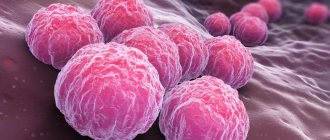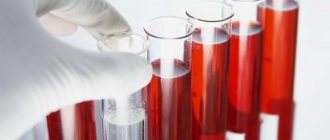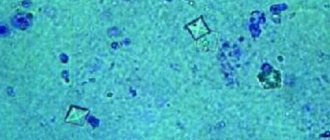Sexually transmitted diseases are pathologies of bacterial, viral or fungal origin that affect the genitourinary system of men and women, which, if left untreated, can affect other organ systems. Pathologies of this kind can be detected through laboratory tests, one of which is a smear for STIs. This diagnostic method allows you to determine the presence of pathogenic microflora in the vaginal discharge in women and the urethra in men. In clinical medicine, it can also be called bacterioscopy or urogenital examination, but this does not change the essence. A regular smear for STIs remains one of the most accessible and inexpensive, but at the same time highly accurate methods for diagnosing sexually transmitted infections.
List of infections for which a smear is taken
Most sexually transmitted infections primarily affect the urethra.
In women, they also penetrate the vagina and cervical canal. It is from these points that smears are taken. Because they have the highest probability of detecting cells or viral particles.
Swabs can be taken for the following infections:
- chlamydia
- mycoplasmosis
- trichomoniasis
- ureaplasmosis
- gonococcal infection
- herpetic infection
- papillomavirus
- candidiasis
- gardnerellosis
Sometimes they also take a smear for syphilis. This is possible if there are rashes on the body. Or if syphilis is in the primary period, and there is primary syphiloma on the genitals.
Symptoms
Many infections occur without symptoms. In women, in half of the cases, gonorrhea and chlamydia have a subclinical course. In men, trichomoniasis often goes away without symptoms. But more often the symptoms are still present.
Possible first signs of sexually transmitted infections:
- enlarged lymph nodes in the groin;
- pain when urinating and during sex;
- the appearance of rashes;
- the formation of a painless ulcer (chancre) on the genitals;
- the presence of discharge from the urethra and vagina.
In the future, other symptoms may appear. In men, this is pain in the perineum, premature ejaculation, blood in the semen. In women - abdominal pain, menstrual irregularities, intermenstrual spotting.
Some STD symptoms are unique to certain diseases. A feature of herpes is the presence of a pronounced intoxication syndrome. With this pathology, bubbles with fluid appear in the anogenital area.
With gonorrhea, there is a profuse yellow discharge from the urethra. In the case of syphilis, symptoms can be quite varied.
At the initial stage of the disease, a crater-shaped ulcer appears on the genitals. In the secondary period - a rash all over the body, usually in the form of small spots. Subsequently, various internal organs may be affected, so clinical signs are very variable.
With human papillomavirus infection, condylomas or warts form on the skin and mucous membranes. These are growths on the skin. They often have to be removed using various procedures.
What STD swabs are not used for
Some infections that are sexually transmitted are not detected in a smear.
The main material for research may be blood. This is a feature of diagnosing those infections that enter the body through the genitals, but do not stay there for a long time. They spread throughout the body.
We are talking about the following infections:
- HIV
- viral hepatitis
- cytomegalovirus
- Epstein-Barr virus
It is also not always possible to take smears for syphilis. This is only possible if there are external manifestations of infection.
In the primary period, a smear can be taken from the chancre.
In the secondary – from elements of the rash.
But often they are not taken. Instead, a blood test is performed to look for antibodies. Serological tests remain the main method for diagnosing syphilis.
Diagnostic methods
There are many STD viruses, so complex methods are used for diagnosis to help establish an accurate diagnosis. The examination consists of the following procedures:
- Donating blood for various tests.
- STD test.
- Carrying out sowing.
- Cultural methods.
- DNA diagnostics.
There is no universal way to detect a virus or determine a disease. The examination consists of the following stages:
- The first step is to take a smear to determine the microflora.
- Bacterial seeding is carried out by collecting secretions from the genitals.
- According to indications, microbiological and enzyme immunoassays are performed to determine antibodies.
- Suspicions of syphilis and HIV require determination of HIV and the Wasserman reaction.
- PCR is considered the most reliable method of examination; the results indicate hidden pathologies that develop without symptoms.
- DNA analysis helps identify pathogenic microorganisms. Very effective diagnostics for viruses in a latent state.
In addition to specialized doctors, patients are referred to other specialists to evaluate internal organs that may be affected.
Where do they take a smear for STDs in men?
In males, a smear is most often taken from the urethra.
This is the tube through which urine and ejaculate pass.
The technique for collecting smears may vary. It all depends on the purpose of the research. For microscopy, it is enough to take urethral discharge.
PCR requires epithelial cells. When collecting smears for bacterioscopic diagnosis, a bacteriological loop or a cotton swab is used.
The bacteriological loop is immersed 2 cm. Then it is pressed against the wall of the urethra and removed. A cotton swab can also be used. The doctor inserts it a little deeper - 3-4 cm.
Then performs rotational movements. After obtaining biological material, it is usually immediately applied to a glass slide.
A smear for PCR is taken with a special probe. It looks like a brush. It allows scraping of the urethral epithelium. This is necessary to identify STD pathogens that parasitize intracellularly.
The probe is inserted into the urethra. They perform rotational movements. It is removed and immersed in a test tube with transport medium.
It is then sent to the laboratory for analysis. Smears are also taken from the surface of the rash. This is possible if syphilis, candidiasis, or herpes are suspected. The rash elements contain bacterial, fungal cells or viruses.
Much less frequently in men, a smear is taken from:
- eye
- throat
- anus
Such smears are studied mainly by PCR. Or their tank is seeded.
A bacterioscopic examination is also carried out. But it is less effective.
There are many bacteria in the mouth and rectum that can be confused with STD pathogens.
In men, smears from other areas of the body, in addition to the urethra, are taken if there are special indications. That is, if there are indications that the patient may have an infection in the mouth or rectum.
Such indications can be either symptoms or medical history. Similar smears are taken if a man notes that he has had anal sex (homosexuals) or oral sex with a potential source of infection.
What types of analyzes are there?
To conduct an STI test, you will need to submit biomaterial, which is collected in a laboratory.
The patient must first be informed how to properly prepare for the study.
You need to be aware of possible false positive results and understand what they are.
First of all, a blood test is taken (capillary blood from a finger or from a vein).
Blood can be used to conduct a general analysis with the determination of leukocytes, ESR, and calculation of the leukocyte formula.
And also for conducting serological tests and PCR.
You can also donate urine in the laboratory, which is used for general analysis, bacterioscopy, culture, etc.
A smear test for STIs is of no small importance.
It is prepared from a sample obtained by collecting it with a sterile cotton swab:
- from the walls of the vagina,
- urethra,
- anus,
- pharynx or mucous membranes of the oral cavity and other places, depending on which organ is affected.
A smear can also be prepared from pathological secretions.
Men can donate seminal fluid or prostate secretions if necessary.
The procedure for taking certain tests is determined by your doctor.
And it depends on what kind of sexually transmitted infection is suspected and what its localization is.
Smear test for STDs in women
In women, swabs are taken from the urethra. Without fail, it is also taken from the vagina and cervix.
According to indications, it can be taken from:
- conjunctiva
- mouth
- anus
A standard flora smear is taken from three points. First - from the urethra. It is massaged with a finger. A portion of discharge appears. It is collected with a swab. After this, a Volkmann spoon is inserted into the urethra. This is a special tool with an extension at the end.
A grooved probe may also be used. After collecting the material, it is placed on glass. Then a swab is taken from the cervical canal for STDs. A speculum is inserted into the vagina and the cervix is exposed. Wipe with a sterile swab.
With the other end of the Volkmann spoon, the doctor penetrates the cervical canal. By scraping, he takes biomaterial. Finally, using a spatula, a smear is taken from the posterior fornix of the shaft.
Smear test for STDs - preparation
To get the right results, you need to prepare properly.
Basic recommendations:
- Avoid sexual intercourse for 2 days
- 3 hours before sampling, do not urinate
For women:
- 2 days in advance you cannot use tampons, do colposcopy or vaginal ultrasound
- do not douche on the day of the test
- Do not come for tests on menstrual bleeding days
- Do not use any vaginal tablets or suppositories for 2 days
You should not start taking antibiotics before taking tests. This increases the risk of false negative results.
Rules for women
Main recommendations for women:
- do not urinate for 3 hours before donating biological material;
- abstain from intimacy for 1.5 days;
- do not use contraceptive ointments and suppositories;
- do not use antibacterial soap during genital hygiene;
- refrain from using antiseptics and douching;
- do not submit material during menstruation;
- Avoid taking antibacterial medications, as they may distort test results.
How long before you take a smear test for STDs after sex?
Often smears are taken not because symptoms appear: urethral discharge or pain. It happens that after sex a person finds out that his partner suffers from sexually transmitted infections. Or he simply wants to play it safe if he had sexual intercourse with a new partner who does not inspire confidence.
In this case, the question arises: when should you go to the doctor to get tested?
Can this be done immediately after sex or should I wait?
There is no point in going to the doctor on the same day or the next. The tests won't show anything.
The pathogen does not immediately begin to be released into the external environment. Accordingly, it cannot be detected immediately after infection.
Microorganisms enter the urethra in minimal quantities. They take several days to multiply and cause an inflammatory response. Sometimes this takes weeks or even months.
Most pathogens begin to be detected in smears after 2 weeks. Sometimes it happens earlier.
It depends on the:
- pathogen
- patient's reactivity
- localization of inflammation
- state of immunity - general and local
- taking medications, etc.
It is better to take smears 2 weeks after sex. Moreover, it does not matter whether symptoms appear.
If there are no signs of infection, this does not mean that they will not appear in the future. Some STDs can occur in a subclinical form. However, they still remain contagious and can cause complications or worsen at the most inopportune period of life.
If symptoms appear, you can contact your doctor to take smears sooner than 2 weeks later. For example, gonorrhea in men often appears as early as day 3. If discharge from the urethra appears, you can go to a venereologist immediately.
When to get tested
Not all infections present with characteristic symptoms. Many pathologies develop without obvious signs and occur in a latent form. Thus, symptoms appear only at certain stages, resulting in acute and chronic infection.
As a rule, the acute form of the disease occurs during primary infection, which makes it possible to quickly identify the infection based on pronounced symptoms.
The main symptoms indicating the need for laboratory tests:
- rash and redness on the skin in the genital area;
- pain in the groin, as well as in the lower abdomen and genital area;
- white or yellow mucous discharge with an unpleasant odor;
- pain and burning during urination;
- the appearance of pimples, blisters and ulcers.
The listed signs do not necessarily indicate infection with an STD. However, symptoms help to make a timely diagnosis. It is necessary to get tested for STDs if:
- In the treatment of infertility, because sexually transmitted infections are one of the reasons.
- During pregnancy planning, to reduce the risk of miscarriage.
- In a screening study to identify hidden viruses.
- After unprotected sex.
Conditions for proper testing for STDs:
- understanding of major research;
- knowledge of the rules for collecting biological material;
- awareness of research preparation methods.
How long before you take a smear test for STDs after antibiotics?
Smears are taken not only for the purpose of primary diagnosis of an infectious disease. This is also required to control cure.
Whatever STD you are being treated for, your doctor will ask you to take pap smears after completing treatment. This is necessary to check whether the therapy was effective.
Confirmation of cure for most infections is carried out in one of two ways:
- PCR swab for STDs
- bacteriological culture
After taking antibiotics, you need to wait at least 2 weeks. After this, you can seed the tank.
To confirm cure using PCR, you often have to wait even longer.
The venereologist may ask you to take these tests a month after taking your last dose of antibiotics. This is due to the fact that PCR is a very sensitive technique. It can detect even single copies of the DNA of microorganisms. This includes identifying the genetic material of bacteria killed by antibiotics. Therefore, if you do not wait enough time after treatment, the risk of false positive results increases.
Will a smear show the flora of an STD?
All patients who contact a venereologist undergo a smear test for flora. This is when the doctor takes discharge from the urethra or vagina and then examines it under a microscope. This study is simple, quick, inexpensive, but at the same time informative. It gives the doctor a lot of information.
First of all, such a smear is necessary in order to understand whether an inflammatory process is present in the urogenital tract. This can be determined by the number of leukocytes. These are cells of the immune system. If there are too many of them, this indicates an active infection.
However, the doctor cannot know what kind of disease has affected the person. Because most STD pathogens are not detected microscopically. But some bacteria, fungi and protozoa can be detected.
Using a smear on the flora, they diagnose:
- trichomoniasis (usually found in women in the vagina)
- gonorrhea (most often gonococci are found in men in the urethra)
- candida
Signs of chlamydia remaining in the genitourinary system may be detected. But their identification is not the basis for establishing an appropriate diagnosis.
Treatment
Having become infected with an STD, the question arises of how to treat the disease. It should be said right away that there is no universal pill for all infections. There are a lot of them, and they are all treated differently. Antibiotics are used for bacterial STDs.
Which drugs and regimen will be prescribed depends on the specific pathogen.
For viral infections, antiviral agents or immunomodulatory therapy are used. For fungal diseases, antimycotics are prescribed.
Some people try to cure infections on their own. To do this, they either go to the pharmacy and buy antibiotics themselves, or use herbs and other folk remedies. Both the first and second approaches are doomed to failure. Choosing the right antibiotic is very difficult.
It is even more difficult to choose the right treatment regimen. In fact, a person is treated at random. But the chances of guessing are low. Because there are dozens of pathogens.
Different types of bacteria, fungi, and protozoa are treated with different drugs. You should also not try to treat STDs at home with folk remedies. This will only lead to the development of complications.
Contact our clinic. We accept both men and women. We employ venereologists, urologists, gynecologists and representatives of other medical specialties. If necessary, anonymous treatment of STDs is possible.
PCR smear for STDs
PCR is the main method for diagnosing STDs.
In just a few hours, this method can detect the genetic material of the pathogen in the patient’s biomaterial. RNA or DNA is detected.
The method has high reliability. It very rarely gives false results, provided that the clinical material is collected, stored and transported correctly. PCR can be quantitative or qualitative.
Deciphering a smear for STDs is not difficult if a qualitative method is used. The result can be positive or negative. If a microorganism is detected, it is written “detected”. If not, then “not detected.”
PCR detects pathogenic bacteria or viruses even with only 100 copies of DNA in a sample. But sometimes the very fact of identifying a microorganism does not indicate a disease. To make a diagnosis, you need to know quantitative indicators. In this case, quantitative PCR is performed. It determines the number of copies of DNA in a sample. This is necessary when diagnosing ureaplasmosis, mycoplasmosis, and candidiasis.
The listed microorganisms may be present in the urogenital tract in small quantities. And only with a significant increase in population can they cause inflammatory processes. The results of such smears are given in DNA copies per ml. Typically the threshold value is 10 to the power of 4. With this result, the doctor believes that the patient requires treatment to eradicate STD pathogens or reduce their number.
The most common STDs
Anyone can become infected with these diseases, regardless of gender, age and social status:
- Chlamydia is an insidious disease that is transmitted exclusively through sexual contact. Most patients have virtually no symptoms in the early stages of the disease. In men, chlamydia manifests itself with characteristic symptoms: cutting pain during urination and ejaculation. This is caused by inflammation of the urethra and epididymis, which is caused by pathogenic bacteria. In women, signs of infection are less noticeable and may not appear at all. However, chlamydia is one of the causes leading to inflammatory processes, ectopic pregnancy, and female infertility.
- Trichomoniasis is a bacterial infection. At the initial stage, the disease does not manifest itself. The incubation period is about two weeks. Men may experience characteristic discharge from the penis, as well as a burning sensation in the urethra. Women have a more pronounced manifestation of trichomoniasis. One of the characteristic symptoms is yellow-green discharge that has an unpleasant odor and cutting pain when having sex.
- Gonorrhea is a fairly common STD, often occurring among people aged 15 to 24 years. The infection spreads in all types of intimate relationships. In men, gonorrhea appears 1-2 days after infection. Patients experience painful and frequent urination and are bothered by copious discharge of pus from the urethra. Gonorrhea requires effective and rapid treatment. In the absence of timely treatment, various complications arise. In women, the temperature rises, bleeding and pain during sex are observed, and the condition of the body as a whole worsens.
- Genital herpes is a viral disease characterized by high susceptibility to pathogens. The virus is transmitted through sexual intercourse and during skin-to-skin contact; the causative agent is HSV-2 (interpretation: herpes simplex virus type II). About a day after infection, small blisters appear on the genitals; their formation is accompanied by a slight tingling and itching. Over the next few days, the blisters turn into painful sores, swollen lymph nodes and fever. Rashes are a visible part of the disease. After they disappear, the virus can remain in the body for many years, and sometimes for life. Lack of timely treatment in pregnant women can lead to various complications, including fetal death.
- Syphilis is an infectious disease caused by a bacterium called spirochete pallidum. You can become infected with this disease through sexual contact of any form. The first symptoms appear ten days after infection - a chancre appears on the perineum or genitals (less often on other parts of the body). Over time, similar rashes appear on the fingers and in the mouth. There is an increase in lymph nodes, especially in the cervical and inguinal. In medicine, there are 3 stages of syphilis. In the absence of timely treatment, the disease can become severe: ulcers spread throughout the body, including the mucous membranes. The patient is worried about aching bones, inflammatory processes and deterioration in overall health. At the third stage of the disease, meningitis may occur. Complications of syphilis can lead to the most severe consequences, such as paralysis or death.
- Human papillomaviruses are sexually transmitted viruses. Regardless of gender, the disease manifests itself in the same way - in the form of warts in the anus and perineum. In men, warts can be hidden in the urethra and behind the foreskin. Human papillomavirus types 16 and 18 are one of the main causes of cervical cancer. It is possible that the disease may be asymptomatic; in this case, you can only find out about the presence of infection after diagnosis.
- Ureaplasmosis is a disease characterized by a chronic course. Its causative agent is ureaplasma, a single-celled microorganism belonging to the opportunistic flora. This means that ureaplasma is present in small quantities in a healthy person. The disease begins to progress when microbes begin to multiply rapidly, displacing healthy microflora. Symptoms appear after 2-3 weeks, patients experience a burning sensation when urinating, inflammation of the genitourinary system and cloudy vaginal discharge. Often women are bothered by pain in the lower abdomen. If left untreated, the disease enters the chronic stage and entails complications: endometritis, colpitis, narrowing of the urethra, cystitis, inflammation of the fallopian tubes, etc. Untimely treatment of ureaplasmosis can lead to premature birth, missed pregnancy and infertility.
- Mycoplasmosis is caused by opportunistic microorganisms. They can be present in the body of an absolutely healthy person and provoke many diseases of the genitourinary system. In men, the disease is asymptomatic, in women there is a burning sensation when urinating, pain during sexual intercourse and pain in the lower abdomen.
- Human immunodeficiency virus (HIV) is the most dangerous of all sexually transmitted diseases. The disease does not appear immediately; its incubation period lasts from three weeks to three months. Symptoms appear only at the stage of manifestation of the process. Patients complain of chronic weakness, inflammation of the lymph nodes, loss of appetite, and headaches. The main characteristic symptom of HIV is a sore throat (inflammation of the tonsils), which does not go away for a long time. Patients' body temperature rises to 37.5°C, which cannot be normalized with antipyretic drugs. The lack of adequate antiretroviral therapy negatively affects the general condition of the patient. The body is attacked by various bacterial and viral diseases: herpes, candidiasis, pneumonia, tuberculosis. And, as a result, AIDS develops.
Smear test for STDs using culture method
Along with PCR, bacteriological culture remains one of the most highly accurate methods for diagnosing STDs.
The smear is sown on a nutrient medium. There bacteria form colonies. They form within a few days.
Bacteria are identified by a number of properties. The doctor looks at what the colonies look like and how they are located. Antigenic or enzymatic properties are assessed.
If an STD pathogen is detected, susceptibility to antibiotics is assessed. This is the main advantage of tank culture over PCR. The method makes it possible to determine which drugs are best to treat the patient in order to immediately obtain the desired result.
Culture is slightly less sensitive than PCR and takes longer.
PCR results can be obtained the next day, and sometimes within a few hours. While tank sowing takes several days.
Pap smear for STDs
DIF is direct immunofluorescence. The technique is used to diagnose chlamydia.
Clinical material is taken from patients. It is treated with fluorochrome-labeled antibodies. Luminescence microscopy is then performed.
With its help, elementary bodies are detected - one of the life forms of chlamydia.
It is optimal to use biomaterial from the cervical canal. In men, a swab is taken from the urethra.
The PIF technique is considered screening. Its sensitivity and specificity are much lower than those of PCR.
If the smears are good, could there be STDs?
It happens that the smears are good, but there are still STDs. This is called a false negative test result. Different techniques have different sensitivities. Sensitivity reflects the percentage of disease detected in patients who are infected with STDs. For example, at 95% sensitivity, 5% of people who actually have the infection will get good results. False-negative tests most often occur during bacterioscopy.
Their risk increases if:
- the smear is not taken from the urogenital tract
- it is taken from a woman
- no obvious symptoms of the disease
- infection occurred recently
Therefore, the absence of STDs in a flora smear does not mean that a person is healthy. Although the detection of gonococci or trichomonas gives rise to an appropriate diagnosis.
With tank culture or PCR, the likelihood of false results is much less.
False-positive smears
Tests can be not only false negative, but also false positive. This means that after a pap smear, a person is told that he has an STD, although in fact there are no pathogens in his body.
Such results are rare. Because modern diagnostic tests for confirming sexually transmitted diseases are highly specific. Nevertheless, they do exist.
With PCR, high sensitivity is not only an advantage, but also somewhat of a disadvantage. Because this reaction is very sensitive to contamination of the clinical material. If at least a few copies of DNA enter the smear from another source - not from the patient's body - then they can be detected. Accordingly, a person will receive a diagnosis that he actually does not have.
False-positive results can also be obtained with bacterioscopy. Especially if the smear was not taken from the genitourinary system.
The mouth and rectum contain bacteria that are similar to those that can cause STDs. The doctor may confuse and write that gonococci have been detected, although in fact the person does not have gonorrhea.
However, false positive results are very rare. Usually, if tests indicate the presence of an STD, then the person is really sick and should receive treatment.
Prevention
The following methods will help prevent STDs:
- Regular and correct use of condoms;
- Avoiding unsafe sexual activity, such as changing sexual partners frequently or having sex with partners who have other sex partners;
- Circumcision (reduces the spread of HIV from women to men);
- Immediate diagnosis and treatment of STDs (to prevent transmission of the disease to others);
- Identification of sexual partners of infected persons, consultation or treatment of such partners.
Abstaining from sex (anal, vaginal and oral) is the most reliable, although often unrealistic, way to prevent STDs.
The only vaccines available are for HPV infection, hepatitis A and hepatitis B.
— How to use a condom?
- Use only a new condom for each sexual act.
- Use the correct size.
- Handle the condom carefully so as not to damage it with nails, teeth or sharp objects.
- Wear a condom after you get an erection and before you have genital contact with your partner.
- Determine which way to unroll the condom by placing it on your index finger and trying to gently unroll it, but only slightly. If that doesn't work, turn it over and try the other way. Then roll it up completely.
- Place the rolled condom on the head of the erect penis.
- Leave about 1 centimeter of the tip of the condom free to collect sperm.
- Squeeze the reservoir of the condom with one hand to release the air.
- If you are uncircumcised, pull back your foreskin before spreading the condom.
- With your other hand, straighten the condom towards the base of the penis and squeeze out any air bubbles.
- Make sure there is sufficient lubrication during intercourse.
- Only water-based lubricants are used with latex condoms. Oil-based lubricants (such as petroleum jelly, tallow, mineral and massage oils, body lotions, and cooking oil) can damage latex and cause the condom to break.
- Hold the condom firmly against the base and remove the penis while it is still erect to prevent the condom from slipping and leaking.
Comparison of STD smear with blood tests
Smears are more informative and accurate than blood tests for antibodies. This applies to both PCR and tank inoculation. This is due to the fact that the pathogen itself is detected in the smear, while in the blood there are only indirect signs of its presence in the body.
Antibodies are not produced by bacteria or viruses. They are produced by the body itself in order to fight the pathogen.
But it happens that there are antibodies, but the pathogen is not. Or vice versa – there is a pathogen, but no antibodies. False results are much more common in blood tests. They can be false positive if a person has had an infection in the past.
False negative blood tests may be due to a lack of antibodies due to:
- weak immunity
- taking blood for testing too early
But serological diagnosis also has advantages.
Thanks to a blood test for antibodies, you can identify the pathogen in the body, no matter where it is located. This is in contrast to swabs, which must be taken exclusively from the site where the pathogen is suspected to be located. For example, if a smear was taken from the urethra, and the bacteria lives in the rectum, then the test will be negative, although in reality the person is sick.
This will not happen in a blood test. Antibodies are produced in any case, regardless of the location of the inflammation.
Another advantage is the ability to determine the stage of the disease and the duration of infection. If diagnosis is carried out using PCR, then it is impossible to know when the microorganism entered the urethra. But blood tests detect different types of immunoglobulins. They appear at different times after infection.
Their titles either increase or decrease. By assessing the titers of various classes of antibodies, including over time, the doctor can get an idea of the timing of infection and the characteristics of the course of the infection.
Pain during STD smear
In our clinic it is not customary to mock patients. We try to carry out all procedures with minimal discomfort. Therefore, our collection of smears is painless. For men we use Katedgel gel.
It contains lidocaine and chlorhexidine.
Lidocaine is a local anesthetic. It “turns off” sensory nerves. Therefore, the man does not feel pain while taking clinical material for analysis. Including if a scraping is taken for PCR.
Chlorhexidine is an antiseptic. It kills bacteria and viruses. Thanks to this tool, the risk of infection during diagnostic manipulation is reduced.
The use of Katedzhel reduces complications of smear collection.
Where to get tested for STDs
You can get a smear test for STDs at our clinic.
Our advantages:
- the swab will be taken by a doctor, not a nurse
- The procedure will be painless thanks to local anesthesia
- we work with the best laboratories in Moscow, which ensures a wide range of studies and accuracy of results
After receiving your tests, the doctor will interpret and advise you. If necessary, treatment will be prescribed. It will allow you to quickly get rid of STDs and return to a full sexual life.
If you need to take a smear test for STDs, contact the author of this article, a venereologist in Moscow with many years of experience.











